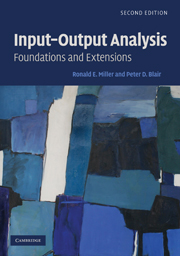Book contents
- Frontmatter
- Contents
- List of Figures
- List of Tables
- Preface
- 1 Introduction and Overview
- 2 Foundations of Input–Output Analysis
- 3 Input–Output Models at the Regional Level
- 4 Organization of Basic Data for Input–Output Models
- 5 The Commodity-by-Industry Approach in Input–Output Models
- 6 Multipliers in the Input–Output Model
- 7 Nonsurvey and Partial-Survey Methods: Fundamentals
- 8 Nonsurvey and Partial-Survey Methods: Extensions
- 9 Energy Input–Output Analysis
- 10 Environmental Input–Output Analysis
- 11 Social Accounting Matrices
- 12 Supply-Side Models, Linkages, and Important Coefficients
- 13 Structural Decomposition, Mixed and Dynamic Models
- 14 Additional Topics
- Appendix A Matrix Algebra for Input–Output Models
- Appendix B Reference Input–Output Tables for the United States (1919–2006)
- Appendix C Historical Notes on the Development of Leontief's Input–Output Analysis
- Author Index
- Subject Index
Preface
Published online by Cambridge University Press: 05 June 2012
- Frontmatter
- Contents
- List of Figures
- List of Tables
- Preface
- 1 Introduction and Overview
- 2 Foundations of Input–Output Analysis
- 3 Input–Output Models at the Regional Level
- 4 Organization of Basic Data for Input–Output Models
- 5 The Commodity-by-Industry Approach in Input–Output Models
- 6 Multipliers in the Input–Output Model
- 7 Nonsurvey and Partial-Survey Methods: Fundamentals
- 8 Nonsurvey and Partial-Survey Methods: Extensions
- 9 Energy Input–Output Analysis
- 10 Environmental Input–Output Analysis
- 11 Social Accounting Matrices
- 12 Supply-Side Models, Linkages, and Important Coefficients
- 13 Structural Decomposition, Mixed and Dynamic Models
- 14 Additional Topics
- Appendix A Matrix Algebra for Input–Output Models
- Appendix B Reference Input–Output Tables for the United States (1919–2006)
- Appendix C Historical Notes on the Development of Leontief's Input–Output Analysis
- Author Index
- Subject Index
Summary
We started working on the first edition of this book (Miller and Blair, 1985) in the late 1970s. At that time, input–output as an academic topic (outside of Wassily Leontief's Harvard research group) was a little more than 25 years old – 1952–1979, give or take a year at either end. We use 1952 because that was when the first author was introduced to input–output analysis in a sophomore-year economics class at Harvard taught by Robert Kuenne, who later claimed that was the first time input–output had been included (anywhere) in an undergraduate economics course.
In 1962, the first author joined the faculty of the Regional Science Department at the University of Pennsylvania. He was asked by then department chair Walter Isard to teach the graduate course in linear models for regional analysis; this was to include a strong input–output component. At that time coverage of the topic in texts was to be found primarily in two chapters of Dorfman, Samuelson and Solow (1958), in Chenery and Clark (1959), in Stone (1961) and in a long chapter on input–output at the regional level in Isard et al. (1960); later there were texts by Miernyk (1965), Yan (1969), and Richardson (1972).
The second author of the current text began teaching an applied course covering extensions of the input–output approach to energy, environmental, and other contemporary policy issues of the time in that same regional science program at Penn in the early 1970s, and by the end of that decade the need for a comprehensive and up-to-date textbook became apparent to us.
- Type
- Chapter
- Information
- Input-Output AnalysisFoundations and Extensions, pp. xxix - xxxiiPublisher: Cambridge University PressPrint publication year: 2009

